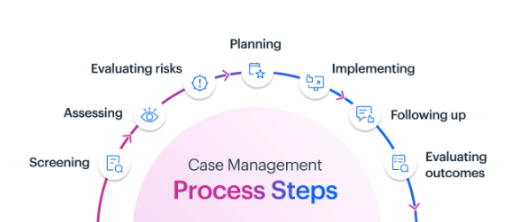Automating the workflow and business processes is one of the most important investments of this digitalized era to save money and expedite operations. However, not all the processes are repetitive with defined outcomes.
For instance, insurance companies need to evaluate whether to approve a patient’s medical claim. How can we streamline and offer a structured approach to handling such complex, non-routine scenarios to facilitate quick and informed decision-making?
The answer lies in case management. It is a collaborative approach to managing cases, optimizing business processes, and driving efficiency. It is a procedure for managing data relationships, documents, and processes for unique cases, like investigations, service requests, and inquiries that require a resolution.
The case management process involves collecting information from a particular entity, such as a patient, employee, or client. It requires recording, monitoring, and analyzing the information to evaluate the risks, which helps a case manager make a problem-oriented plan.
So, let’s discuss everything about case management, including the process involved and examples in detail.
Understanding Case Management
Case management is a software-based approach that combines human action with intelligent automation to optimize diverse business activities. It includes:
- Project management
- Investment portfolio management
- Compliance tracking
- Vendor management
- Contract management
- Grant management
- HR grievances
- Incident resolution
- Fraud investigation
How is Case Management Different From BPM?
While both case management and BPM (business process management) focus on improving organizational processes, case management offers a more holistic approach. It is preferable to manage work processes that are non-repetitive or vary as per time. Case management solutions are designed to work for both knowledge-driven processes and general processes, optimizing the outcomes.
Although the definition and meaning of case management may vary from industry to industry, the processing method is almost the same. Case management is a core element of building business applications. It manages complex human and machine tasks to achieve desired outcomes.
When case management processing begins, case managers evaluate a company’s needs and determine how to provide appropriate solutions using the available resources. Depending on the service or product a company delivers, a case might involve a variety of concerns. When a new case is opened, a case manager determines which services are technically essential.
While both case management and BPM (business process management) focus on improving organizational processes, case management offers a more holistic approach. It is preferable to manage work processes that are non-repetitive or vary as per time. Case management solutions are designed to work for both knowledge-driven processes and general processes, optimizing the outcomes.
Although the definition and meaning of case management may vary from industry to industry, the processing method is almost the same. Case management is a core element of building business applications. It manages complex human and machine tasks to achieve desired outcomes.
When case management processing begins, case managers evaluate a company’s needs and determine how to provide appropriate solutions using the available resources. Depending on the service or product a company delivers, a case might involve a variety of concerns. When a new case is opened, a case manager determines which services are technically essential.
The Case Management Process: 7 Easy Steps
The case management process involves the following seven steps:

Step 1: Screening
Screening is the first step in case management. This step ensures whether the process is necessary. If not, the case manager will stop doing unnecessary work and keep the system tidy.
The other scenario that is considered at this step is whether the incident is justified or just a misunderstanding. In this case, the company may not proceed further with the process as case management is for solving complex problems, not addressing simple issues.
Step 2: Assessing
While accessing the case, the case manager will analyze the whole incident in greater depth and gather information. It will give a clear picture of the incident and a better understanding of the problem, which helps to provide an appropriate solution.
For instance, a case manager can ask questions individually from the client or employee to gather all the needed information about the case.
Step 3: Evaluating Risks
After gathering all the data, the case manager will now proceed to evaluate the case’s risks. The case manager can classify the case according to three categories:
- low-risk
- moderate-risk
- high-risk
Evaluating risks allows the case manager to categorize them to see the severity and urgency of each case. With this evaluation, the manager will be able to prioritize them based on severity. It helps to evaluate the levels of intervention required for each one.
Step 4: Planning
In this step, the case manager will develop a case-specific solution plan. Planning aims to mitigate the impact of risks and coordinate the overall organization. It is an effective way to solve the problems discovered in the evaluation by taking specific actions.
The case manager can choose how and when to execute the plan. For instance, if it’s an employee complaint, the manager may decide whether to use company resources or call for outside help.
Step 5: Implementing
The implementation phase is where the real work happens in resolving a case. These implementations include hiring experts, acquiring tools, making appointments, and whatever else the job may demand. During the implementation phase, effective communication and collaboration with all parties involved—clients, team members, and external stakeholders—are also crucial.
Moreover, monitoring the process closely and adapting strategies as needed can significantly improve the chances of a successful resolution.
Step 6: Following-up
In this step, a case manager will once again analyze the incident to see how effective implementation was. The case manager will assign appropriate teams or agents to gather information and see if the problem persists.
If the existing plan needs some changes, the case manager goes back to the planning step. Then, the necessary steps are taken, and additional follow-ups are conducted to determine whether the novel approaches fixed the problem.
Step 7: Evaluating Outcomes
The final step in case management is to evaluate outcomes. Evaluation provides an opportunity for clients, customers, and employees to give feedback on the system. For evaluation, the case manager will collect this feedback and analyze key metrics like documenting actions, results, quality, cost, and duration of the case handling process.
Following analysis, the case manager will prepare an evaluation report to determine the return on investment and the cost-benefit of the entire process.
Case Management Example
Here are two case management examples that will provide you with a clear idea about its processing:
Example 1: Incident Report
An incident report documents an out-of-the-ordinary event within a company. It can be done physically or digitally and requires investigation and resolution.
How to approach:
- First, identify and report incidents.
- Encourage users and technicians to register all incidents.
- Integrate self-service mechanisms for users to report incidents.
- Maintain a comprehensive knowledge base of known problems and errors.
- Hand over the escalated incidents to the appropriate teams. The team will investigate and try to resolve them.
- Relate incidents to relevant configuration elements for better management.
Example 2: Service Request
A service request is a formal request made by a customer or employee to receive specific services. These requests can be software upgrades, password resets, or account creations.
How to approach:
- Firstly, establish a user-friendly centralized service portal for service request submission.
- Streamline assessment and approval processes.
- Assign requests to the appropriate teams or agents for fulfillment.
- Integrate self-service tools to reduce recurring requests.
- Monitor the request backlog and resolution times for efficient service delivery.
How Does Case Management Software Help Case Managers?
In the banking and insurance industry, case management software can help to identify and resolve cases related to fraud, KYC, AML, and more. With a robust bank-supported financial product, you have to manage myriad workflows, including:
- Risk and compliance workflows,
- Marketing and disclosure workflows,
- Customer service workflows, and
- Administrative workflows.
Now, all these workflows can be managed using spreadsheets, shared drives, emails, or even a project management tool like Jira Tickets or Asana Boards. Besides, a dedicated employee is required to complete the proceedings: from analyzing the incident to getting a follow-up. Managing workflows through these mediums can lead to inefficiencies, manual errors, and miscommunication.
What if the entire process of case management can be automated with robust and intuitive case manager software?
Real-life business scenarios often present complexities that make decision-making challenging. With NewgenONE’s Case Management, you can address these challenges by empowering users to extrapolate subjective decision-making beyond the process flow canvas into real-time workflow simulation. It allows business users to choose from pre-defined tasks or create new tasks from scratch, streamlining complex processes and enhancing efficiency.
NewgenONE’s case management capabilities enable employees to collaborate and respond to real-time incidents efficiently, handling comprehensive case-related information, documents, and communications from one place.
Here is how the NewgenONE Platform, a unified low-code platform for end-to-end automation, helps:
- Simplified case creation and configuration using a global task library
- Design and deploy synchronized, ad-hoc processes and amend case routing structures to handle unanticipated situations
- Real-time case sharing and collaboration to facilitate better decision-making
- Streamlined data visualization through a unified case file with all the case data, tasks, documents, forms, to-do lists, and others
- Enhanced flexibility to handle complex cases that involve multiple stakeholders
- Receive automated notifications on task initiation, completion, reassignment, completion, decline, and failure through system-generated notifications
Newgen Case Manager
NewgenONE allows businesses to handle such cases diligently, from initiation to resolution, by seamlessly managing information, offering domain expertise, and making judgements. NewgenONE’s Case Management offers a Case Workdesk that allows the designer to associate tasks with a particular step. So, whenever a user performs the process and reaches a particular step, they can easily perform all the related tasks.
Case Workdesk
NewgenONE allows businesses to handle such cases diligently, from initiation to resolution, by seamlessly managing information, offering domain expertise, and making judgements. NewgenONE’s Case Management offers a Case Workdesk that allows the designer to associate tasks with a particular step. So, whenever a user performs the process and reaches a particular step, they can easily perform all the related tasks.
Configuring Case Workdesk in NewgenONE’s Process Designer
Here’s how users can configure the Case Workdesk in NewgenONE’s process designer:
Select the Case Workdesk, which is listed under the activities in the toolbar. Users can drag and drop it into the work area.
Now, the user should invoke the Case Workdesk properties to complete the configuration. Its properties include basic details, initial rules, entry settings, requirements, attachments, workdesk, tasks, streams, options, and data fields.
By configuring the settings in the basic details tab, the users can generate the case summary document. It is essential to select the Generate Summary Document to enable the auto-generation of the case summary document.
The document containing the case details is generated once the Case WorkDesk is marked as completed. The work item is routed to the next step.
To complete the case workdesk configuration, it is a must to configure the task tab. The task is used to define properties for associating tasks with a Case Workdesk. The task tab can associate tasks by clicking which populates are unassociated with the Case Workdesk.
Now, the users can select the required tasks from the list by checking the checkbox and clicking the associated task button post. Here are the options that will appear to complete the configuration:
- Users: This option permits users to choose a specific user or group with the Right to Work on tasks during runtime.
- Data Mapping: It allows to map the task variables with process variables. This means the data of selected task variables are to be passed to the process’ corresponding mapped variables.
- Rules: It permits define the rules to set pre-conditions to initiate the tasks. The system will start the tasks as the pre-conditions are met while executing the process.
- Rights: It allows to grant/cease read or modify permissions on to-do lists, documents, exceptions, and forms. When the read or modify permissions are not given, the end user working on the Case Workdesk cannot view or modify the items while executing the process.
Working with the Case Manager
Besides, the case manager is easy-to-use with a user-friendly interface. Here’s how users can get adapted to working with NewgenONE’s Case Manager smoothly:
- The first step is creating and configuring the Case Workdesk. The user can work and manage cases and associated tasks using NewgenONE’s Workspace.
- In the My Cases tab in Workspace, users can view their assigned cases and tasks. They can complete a case, set a priority/reminder for it, or reassign it. Users can even view the assigned tasks and reject or reassign a particular task or a set of tasks.
- The My Tasks tab allows users to view all the task details and associated case data. In task details, users can view the template associated with the task. The case data displays the form associated with the case.
- Users can even view their tasks through the All Task tab, which comprises all the tasks in that case at that work step. They can add a new task, initiate a new task, revoke the initiated task, view the document list attached to the case and view related case details.
- Users can view and monitor the case progress through the Progress Tab, which provides a graphical representation of all the activities, tasks, and cases completed or initiated.
Types of Case Management Models: NewgenONE’s Offerings
There are primarily three types of case management models:
1. Investigative Case Management (ICM)
Investigative case management is a long-term intervention meant only for people or incidents that require critical and ongoing support. It is used to determine long-term goals over very short periods. This makes it an intensive program designed similarly to the Assertive Community Treatment Model (ACT) but with faster-paced programming.
In ICM, case managers deliver direct, hands-on, and high-quality support services. It is often used for the most complex cases, such as
- Tax-related issues
- Credit and insurance fraud
- Legal investigations
- Background checks
- IP protection
It uses powerful analytics and audit capabilities to investigate these issues across several corporate processes.
2. Service Request Management
Service request management, or request fulfillment, is a formal request from users, asking a service provider to provide something they want or require. It is requesting access to something that is not currently available to the user but is useful in the business’s day-to-day operations. These requests could be anything—whether that’s access to a service, advice, approval, or information.
It is often used for:
- Insurance and healthcare claims
- Warranty fulfillment
- Telecommunications service provisioning.
3. Incident Management
The purpose of incident management is to identify an incident (such as dispute resolution, HR grievances, etc.), resolve it, and restore operations as quickly as possible. These incidents must be rectified on time to avoid future re-occurrences since they affect the service organization’s ability to meet its service assurances and system requirements.
If an incident is not managed properly and timely, it may result in severe disruption to business operations or services. Incident Management can be used for:
- Dispute resolution
- HR Grievances
Wrapping up,
Consequently, businesses that use outdated methods for handling cases might have issues and limitations. These limitations and incidents affect the consistency and overall productivity of the business.
However, implementing an effective case management model depending on the incidents can increase business productivity. It equips you with tools that help you make better decisions. It is one of the perfect solutions for banking and insurance case management.
Through traditional methods, business users have to follow the workflow of assessing the risk profile, investigating the claim based on policies, and arranging for payment if all the criteria are met. However, case management software can digitalize the paper trail, especially in cases of property and casualty or life and annuity, which involves hefty paperwork. It allows insurers to look through relevant information easily and have all the data in a centralized place to avoid approving fraudulent claims.
You might be interested in


31 Aug, 2023
Case Study: Leading Government Intelligence Agency Leverages Newgen’s Case Management Solution to Prevent Suspicious and Fraudulent Financial Transactions

29 Mar, 2024
Case Study: A Dubai-based Emirati Holding Company Simplifies its Document and Records Management with Newgen

